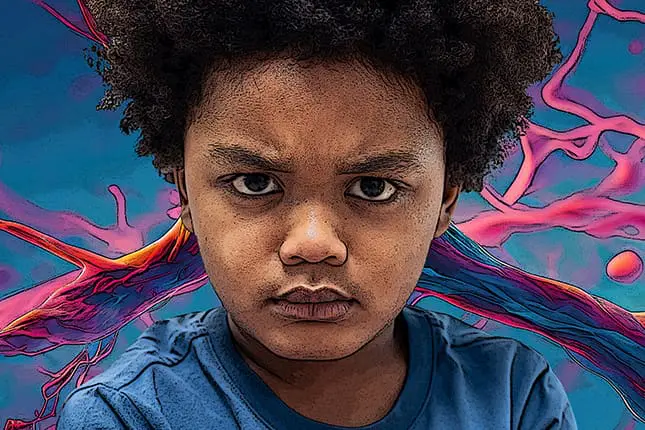It was happening again. Nine-year-old Gerald was fed up with the teacher asking that he stop drumming his sneakers against his desk and instead focus on his assignment. Now she was coming closer, rounding the table where three girls were busily copying down the vocab words she’d written on the whiteboard. His little heart started racing as the heels of her shoes landed louder with each step. The closer she got, the more his leg jiggled the desk. Then came that familiar buzzing sensation eclipsing the thoughts in his head. He squinted his eyes and tried to will her away using mind control, like Professor X from X-Men. He really didn’t want to cause a fuss (couldn’t she see that?), but now his body was positively thrumming.
“Gerald!” she said loudly enough for the other kids to notice.
As he registered the tone in her voice, some last protective wall fell away inside him, and he bolted toward the door.
It’s the ODD, his teacher, Serena, told herself as she blocked the door with her body and called the office for support. It’s not his fault that he’s out of control. Sheri in counseling says I need to have compassion for him. But, honestly, where is Sheri now? How do I deal with this without derailing the class? ODD! I should’ve seen this coming. How am I going to manage?
A Label that Leads to Othering
The diagnostic criteria for oppositional defiant disorder (ODD), as laid out in the DSM-5, includes a pattern of behavior lasting at least six months and evidenced by at least four symptoms from any of three categories: angry/irritable mood, argumentative/defiant behavior, and vindictiveness. These symptoms typically appear during the preschool years and rarely later than early adolescence.
An ODD diagnosis can serve some important functions. It can help people gain access to services and insurance coverage, and it often gets the attention of school districts. A practitioner diagnosing ODD might advise that a child begin therapy, which gives parents and teachers the chance to improve their interactions with the child and offer appropriate support. But that’s where the benefits seem to end.
Some diagnoses can serve to help individuals respect their authentic identities, come to see themselves as part of a community, and advocate for system change. This is the case for many autistic and neurodivergent adults. But there aren’t associations that I know of that offer connection and community for those diagnosed with ODD. Instead of helping a child be better understood and fairly treated, ODD, more than any other diagnosis I’ve seen, can be downright damaging.
Far too often, when kids or teens are diagnosed with ODD, parents, caregivers, teachers, and therapists begin to view them differently. Oppositional. Defiant. When these words are connected to the word disorder, it can easily lead to othering—seeing the person diagnosed as defective, disordered, and intrinsically alien.
I’ve been part of many teams working to support a student diagnosed with ODD, only to hear a school administrator say something like, “This teacher already has two ODD students in her classroom; we can’t give her another.” The tone and tenor of such comments hardly engender compassion for the student, but rather caution and even fear—like a sign saying, “Danger! Discipline problem!” Though keeping teachers supported in their often-challenging work is a worthwhile priority, an ODD diagnosis can provoke preconceived notions that alter how people interact with a child, even before they’ve met them.
Parents, too, feel the brunt of the diagnosis. Again and again, they’ve told me about how they blame themselves for having a child who’s chronically defiant. “What did we do to cause this?” they ask.
Recently, I conducted a Facebook survey about people’s experience of an ODD diagnosis, and hundreds of parents weighed in with comments:
“The worst thing about this overused and inaccurate diagnosis is that it gets your kid a label at school: they’re called ‘emotionally disturbed’ and given a whole bunch of behavior plans that do more harm than good.”
“The ODD diagnosis didn’t clarify why my son’s behaviors were happening, but it made it seem reasonable to exclude him from school. He was later diagnosed with significant hearing loss.”
“Years after my child’s ODD diagnosis, I discovered that her issue was not an unwillingness to do what was asked of her, but an inability to follow directions due to her anxiety. I wish I knew then what I know now.”
“We fought the label on the IEP because I know firsthand how the child is perceived by teachers and school administrators once they get it. I now homeschool my beautiful son.”
“After we got the ODD diagnosis, everybody in our life believed it was time to ‘come down harder’ on my kid. It’s been incredibly difficult to explain that I don’t believe being more stern will ultimately help my child.”
One special education teacher noted, “It automatically puts the teacher and child at odds and gives the teacher a reason to say, ‘See? They’re being defiant!”
One therapist wrote, “I find that many adults who were given the diagnosis as children can speak quite clearly about what other things were happening in their lives that might’ve contributed to behavior that a school labeled ‘oppositional.’ They’ll often report the diagnosis only worsened their childhood experiences and that they’d internalized it in a way that equated them with ‘bad people.’”
One social worker observed, “Many of the kids I came across with an ODD diagnosis had underlying, unprocessed, ignored trauma. But their trauma was overlooked because they were angry and acting out. This was especially true for foster youth.”
Below the Tip of the Iceberg
According to his parents, my client Gerald was difficult to soothe as a toddler. His preschool teachers reported that he was picky, controlling, and defiant, and that he often resisted participating in activities. In kindergarten, after he kicked a classmate, his private school expelled him, and his parents enrolled him at a public school, where a psychologist diagnosed him with ODD, and where his teacher, Serena, struggled to support him in class.
Another client, Martel, entered the foster-care system at the age of four after suffering from years of early neglect and physical abuse. His foster parents had such trouble managing his challenging behaviors that he was placed in three successive homes. At seven years old, he received multiple diagnoses, including ODD, autism spectrum disorder, and ADHD. Eventually, he moved into a group home, where he punched a fellow resident and ended up in juvenile detention at 14.
I’ll get to how Gerald’s and Martel’s lives improved once the adults in their lives were able to move beyond the diagnosis and instead look at what was underlying their behavior. For now, just consider that ODD isn’t so much a diagnosis with a clear origin as it is a jumbled description of a grab bag of challenging behaviors. If we pause and consider these behaviors from a developmental context, we’d see they’re not disordered at all, but the adaptive and protective responses of a child experiencing stress.
From birth—and even before—our nervous system is in constant dialogue with our external and internal worlds. Its job is to produce protective responses to stress, as well as to help us recover from stressful situations. In this light, we can understand the prognostic features of ODD as protective. Stephen Porges, with his now widely embraced Polyvagal Theory, has helped bring this understanding of the nervous system to the fore and highlight how feeling physiologically (and subconsciously) safe is a biological imperative for all of us.
Porges calls the subconscious surveillance of safety and threat neuroception. I call neuroception the body’s safety sensor, working around the clock to try to keep us out of harm’s way. This is accomplished through another process, interoception: the way sensations provide information subconsciously to the brain about the internal state of the body. Becoming aware of the impact of neuroception—feeling your heart racing or your stomach twisting or gurgling, for example—is called interoceptive awareness. Burgeoning neuroscience research ties interoceptive awareness to emotional self-regulation. In the therapy room, this translates to more opportunities to help clients increase their interoceptive awareness and enhance their ability to self-regulate.
Why do I mention all of this science? Because it challenges the assumption that oppositional and defiant behaviors appear from out of nowhere. There’s a good reason for them. And the reason isn’t always—or even usually—a “stubborn,” disordered kid. Often, it’s a child whose safety sensor is going off, even when the child is objectively safe. Maybe the signals coming from interoception are guiding the child’s perception toward a negative bias and informing their basic feelings and emotions. When a nervous system detects what it perceives as threat, the child can become controlling, oppositional, defiant, and intrusive. Sudden and extreme shifts into such behaviors are a fight-or-flight response, signs that the sympathetic nervous system has been activated.
As Serena approached Gerald in the classroom, his brain predicted that she’d reprimand him—which she did. He wasn’t consciously aware that he was jiggling his leg against the desk and disturbing people, so the reprimand didn’t make sense to him. He felt even more desperate when she called him out in front of the class. Now cue the sympathetic nervous system pathway of protection via movement. This pathway is automatic and nonintentional, and before Gerald knew what was happening, his body was bolting toward the door. What looked to the adults around him like an agitated, defiant, and angry kid was a vulnerable nervous system in protective mode.
When we see a child responding with resistance or anger to demands, challenging requirements, changes in the environment, or adults’ expectations, we should consider the child’s subjective reality. How is their nervous system processing what’s happening? What’s causing the stress? Is a lack of emotional flexibility getting in the way of their ability to cooperate? If we want to support children traditionally viewed as ODD, we need to look beneath the tip of the iceberg of their behaviors. Our treatment should reorient from punishing a child for acting out to helping their nervous system feel safe. We need to teach children how to access social engagement—the healing balm for sensitive stress response systems—as a grounding resource.
The Problem with the Current Protocols
The most popular current approaches to ODD focus on behavior management. One such approach is Parent Child Interaction Therapy (PCIT), in which a therapist, watching from behind a one-way mirror, coaches parents as they interact with their child. Parents are first instructed to reinforce positive behaviors and nurture the attachment relationship. This part of PCIT isn’t problematic: it makes sense and can be helpful. But when challenging behaviors emerge, parents are coached to shift to traditional behaviorism: reinforcing desired behaviors and ignoring the child and their negative or undesired behaviors.
For example, if a behavior is deemed undesirable or noncompliant, the parent is instructed to withdraw attention—to avoid looking at or interacting with the child—thus using the attachment relationship as a reinforcer. Ironically, doing so can have a dysregulating effect on a child’s nervous system. When a nervous system is in the fight-or-flight pathway, the child needs coregulation—calm, attuned support—from adults, not a break in that support.
While research has supported PCIT and other behavior-based programs, I question the research methodology and what exactly the studies were measuring. It’s easy to show that a child who’s being ignored shifts their behaviors to regain support, and that their behaviors change as a result. But at what cost? Was their nervous system physiology measured during or after the intervention? Was their stress response activated? To my knowledge, studies that cast PCIT as effective haven’t used biomarkers, which measure stress physiology: they focus on children’s behaviors without tracking and understanding the cost to their bodies. Many of these children learn how to mask their emotions and behaviors to please the adults around them.
Over the years, many parents and children dealing with an ODD diagnosis have left these therapies behind in search of a better approach. As one parent told me, “I did PCIT with my son, and while I thought it was helpful at the time, I now look back and see it as also very cruel. There were a lot of time-outs and segregation. I think a lot of my child’s compliance resulted from fear of being rejected.”

New Solutions
By seeing the behavioral patterns we call ODD as indicators that a child is experiencing a stress response, we can address the root causes of disruptive behaviors. We can attune to and be present for children with activated nervous systems via coregulation, increasing their sense of safety through our own compassionate, calm state.
When I worked with Gerald, a new picture of his inner reality emerged as we explored the evolution of his nervous system from the time he’d been a toddler. His early hypersensitivity to sounds and certain types of touch had contributed to a sensitivity to the environment. He hadn’t purposefully chosen to be difficult to soothe as a baby, nor picky, controlling, and defiant in preschool. His intent had never been to make life difficult for those around him. His “opposition” and “defiance” were actually self-protective.
With this new understanding, we focused on coregulation rather than reinforcement schedules. I brought in an occupational therapist to help us understand his sensory processing issues. I’ll never forget the debrief session with Gerald’s parents and his teacher. The occupational therapist created a visual map showing how his early sensitivities had played a role in his perceptions, feelings, and emotional and behavioral responses. As the session ended, his parents were so grateful they spontaneously hugged her: they hadn’t been blamed for their son’s challenges, and he hadn’t been blamed, either. The paradigm made much more sense to them than any of Gerald’s previous, behavior-focused therapies. After a few months of sessions, the adults in his life understood him better, and he began to thrive at school.
Martel, for his part, was assigned a social worker who viewed his ODD diagnosis through a lens that was both trauma-informed and trauma-responsive. She had training in the impact of toxic stress and the ways developmental trauma can lead to unpredictable and extreme behaviors. In her work with Martel, she focused not only on behavior management but on increasing his sense of relational safety and predictability. He began confiding in her, sharing stories from his childhood that he’d never told anyone, like when he was left alone in a house at age seven for two days. After two months in the juvenile detention center, he transitioned into a supportive, well-managed, small community group home. He continues to see his social worker, whose focus on relational safety likely helped him avoid a life behind bars.
What Therapists Can Do
Therapists can help stem the tide of the use of this diagnosis and the negative connotation it evokes by considering the following therapeutic suggestions.
Build or rebuild a sense of connection with trusted teachers, therapists, and caregivers. All children, regardless of age, need consistent attention to their emotional and physical needs. This includes loving attention when they feel distress and the consistent support of an adult who understands when their behaviors indicate a body-up response and not simply willful or purposeful misbehavior.
Consider each child’s vulnerabilities and individual differences. Some children have unique constitutions that can make it more difficult to calm themselves. These can include over- or underreactivity to touch, sound, smell, movement, emotions. They can also involve a history of developmental trauma. Understanding a child’s individual differences and history is key to supporting a neuroception of safety.
Help children signal when they need help and feel vulnerable. What’s termed oppositional defiance is often a reaction to feeling small, helpless, and out of control. We should nurture each child’s ability to signal—verbally and nonverbally—that they feel uncomfortable or anxious.
Provide the correct customized support for each child. Determine the best way to understand how parents, teachers, and caregivers can coregulate with each child’s nervous system needs and responses. You might consult with occupational therapists well versed in sensory integration if the child has a significant early history of overreactions to sensory input. And consider using play to support spontaneous social engagement. Joy, play, and connection promote biobehavioral coregulation, which builds a child’s capacity for self-regulation.
Provide attunement, coregulation, boundaries, and a predictable environment. The way to help children feel safe isn’t more rules and punishments—which make the child feel blamed—but personal attunement that helps them manage intense stress responses. Parents can have clear boundaries and be authoritative while being warm and supportive at the same time. And the human brain is soothed by predictability. Giving children a relationally safe and predictable environment should be a goal in parenting, childcare, and education.
Ultimately, it’s time we move beyond the ODD diagnosis, with its checklist of symptoms separate from their causes. Although rigid avoidance of this diagnosis isn’t our only option, as mental health professionals and as members of the larger culture, we need to shift the way we understand our relationship to distressed children—from one that pathologizes and blames, to one that encourages curiosity, compassion, and understanding. Whether we’re clinicians, parents, or teachers, we have countless opportunities—big and small—to help children understand and regulate their own nervous systems and create safety in a world that can sometimes feel threatening.
MAIN ILLUSTRATION © ADOBESTOCK/JOSHUA
SECOND ILLUSTRATION © ADOBESTOCK/KAWEE
Mona Delahooke
Mona Delahooke, PhD, is a clinical psychologist empowering joyful, resilient parent-child relationships by translating neuroscience research into practical and compassionate tools and strategies. Learn more at her website.














